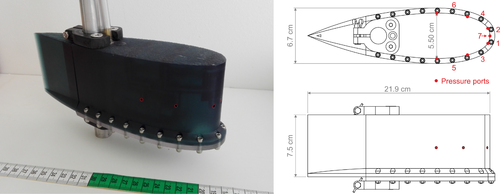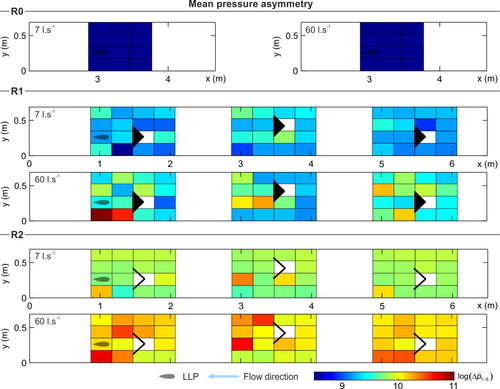Differential pressure sensor base artificial lateral line probe, iRon
Contents
Quick summary
NOTE: the citations in this article need updating. Wrong format.
Developed by: Centre for Biorobotics
Date: 2016
Type: Device
Suitable for the following [[::Category:Measures|measures]]:
Introduction
“iRon” is a device that mimics the lateral line sensory system used by fish in nature (artificial lateral line) and that allows the characterization of flow fields from a fish perspective. First artificial lateral lines were developed to provide sensing capabilities to small underwater robots (EU project FILOSE, 2009-2012 [1]) and they were further developed for environmental monitoring in BONUS FishView project (2013-2016) [2].
In contrast to conventional flow measuring devices (such as ADVs, propellers, etc.), they are streamlined bodies which record the spatial distribution of fluid-body interactions at a sampling rate close to that of the sensory organs (up to 400 Hz in the latest designs). From these records, point-based hydrodynamic parameters such as velocity or turbulence metrics can be estimated, but also body-oriented metrics (“flow asymmetry”).
iRon belongs to a new generation of artificial lateral lines where an increase of sensitivity is achieved by the use of differential pressure sensors. It consists of a 0.22 m long NACA025 streamlined body, which measures the pressure gradients simultaneously using six differential pressure sensors (±2000 Pa MPXV7002). In addition, the water depth is measured by the probe using an absolute pressure sensor (0 to 10000 Pa – MPX5010GP) (Figure 1).
Application
Artificial lateral lines have been successfully applied to estimate flow variables such as velocity [4]–[7] turbulence [4], [5] and also for hydrodynamic classification [8], [9] (Figure 2).
iRon was specially developed for FIThydro project and was designed to conduct biological assessments. The device has been successfully applied to study fish habitats and their spatial preferences [10] as well as to analyze fish’s behavioural responses [3]. To achieve this, the raw data of iRon is translated into body-oriented metrics, mean pressures sensed by the body, pressure fluctuations around the body or asymmetries around the body [10].
In fishways, iRon has shown the potential of characterizing the spatial preferences of fish under variable hydrodynamic scenarios (Video 2) better than standard technologies such as ADV [10]. Among other, this seems to be induced by the higher dimensionality of the iRon that may aid in improving the characterization of fish’s hydraulic preferences.
Another application of iRon has been the characterization of hydrodynamic signatures generated by different refuge structures under hydropeaking scenarios to after analyse fish behavioural responses [3] (Figure 3). This study, among other results, demonstrated the importance of asymmetric flows in the refugee selection by fish, which generates a unique signature in iRon for each scenario and configuration.
All the characterizations so far have been elaborated considering mean differential pressure recorded by the flow, mean fluctuations of differential pressure and mean asymmetries between both sizes of the body [3], [10]. However, the available data can be further exploited, for instance considering the frequency domains of the recorded signals.
Other information
The total costs for the geophone and accelerometer sensors amount to approx. 885-1'330 €. The costs for the field computer, the analog-digital-converter, and the 3G modem are approx. 5'300-6'200 €. Additional costs for the installation, data transmission, and the calibration depending on the site conditions and set-up.
Relevant literature
- Albayrak, I., Müller-Hagmann, M., Boes, R.M. (2017). Calibration of Swiss Plate Geophone System for bedload monitoring in a sediment bypass tunnel. In Proc. 2nd Intl. Workshop on Sediment Bypass Tunnels (Sumi, T., ed.), paper FP16, Kyoto University, Kyoto, Japan
- Gray, J.R., Laronne, J.B., Marr, J.D.G. (2010). Bedload-surrogate Monitoring Technologies, US Geological Survey Scientific Investigations Report 2010-5091. US Geological Survey: Reston VA.
- Rickenmann, D., Turowski, J.M., Fritschi, B., Klaiber, A., Ludwig, A. (2012). Bedload transport measurements at the Erlenbach stream with geophones and automated basket samplers. Earth Surface Processes and Landforms, 37, 1000-1011.
- Rickenmann, D., Turowski, J.M., Fritschi, B., Wyss, C., Laronne, J., Barzilai, R., Reid, I., Kreisler, A., Aigner, J., Seitz, H., Habersack, H. (2014). Bedload transport measurements with impact plate geophones: comparison of sensor calibration in different gravel-bed streams. Earth Surface Processes and Landforms, 39, 928-942.
- Wyss, C.R., Rickenmann, D., Fritschi, B., Turowski, J.M, Weitbrecht, V., Boes, R.M. (2016a). Laboratory flume experiments with the Swiss plate geophone bed load monitoring system: 1. Impulse counts and particle size identification. Water Resources Research, 52, 7744-7759.
- Wyss, C.R., Rickenmann, D., Fritschi, B., Turowski, J.M, Weitbrecht, V., Boes, R.M. (2016b). Laboratory flume experiments with the Swiss plate geophone bed load monitoring system: 2. Application to field sites with direct bed load samples. Water Resources Research, 52, 7760-7778.


